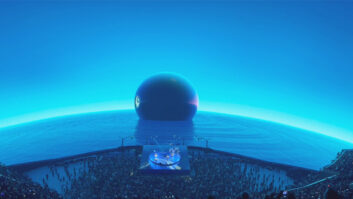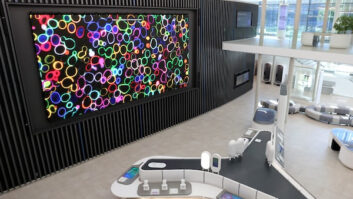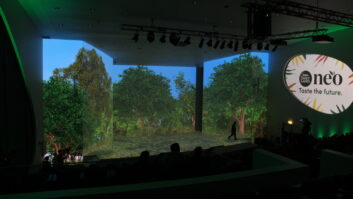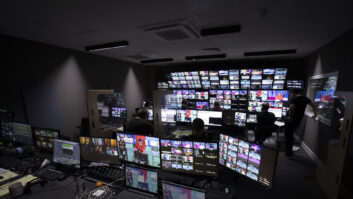
Previously we considered the state of 4K as manufacturers continue to push the boundaries of resolution, followed by a look at the debate over the timeframe to 4K becoming an industry standard. We conclude by presenting the advantages and disadvantages of High Dynamic Range as well as the growth potential of OLED technology, writes Ian McMurray.
High Dynamic Range (HDR) displays are capable of delivering a greater range of brightness and luminosity, with a peak brightness around 10 times that of non-HDR screens. Here, the trick is not more pixels – but making each pixel better. The result? A more realistic, more engaging image. Many believe it can be more significant than 4K. Inevitably, there are downsides. First: HDR content must be specially created – and, as yet, there’s not much of it about, although Netflix has committed to it. Second: delivering better pixels comes at a cost of around 20% additional bandwidth. On the other hand: 2K resolution with HDR requires less bandwidth than 4K resolution, and 4K/HDR less bandwidth than 8K. And third: there is, as yet, no industry standard for HDR.
Visibly superior
In theory, the big advantage of HDR over 4K is that images are visibly superior on even the smallest screen sizes, making HDR more of an across-the-board solution. That advantage, though, may be more significant in the consumer market than in the pro AV market where, as Enrique Robledo, Panasonic’s European marketing manager notes, screen sizes are typically larger and thus derive more benefit from greater resolution.
Tobias Augustin, product manager, large-format displays at NEC Display Solutions Europe, isn’t sure either. “While 4K resolution offers better image quality, and thus a real benefit for many applications and markets, the benefits arising from HDR will only address a very small market,” he claims. “It’s easy to create images and videos in higher resolution, even with consumer-grade cameras like smartphones or action cams, but creating HDR content is much more cost intensive. The limited availability of HDR-capable LCD panels will also have an impact. Next-generation high-end displays will feature HDR, but it will take some more time to develop good product packages at a reasonable price.”
Given its potential for improving image quality while consuming much less bandwidth than 4K, it would be tempting to believe that 2K/HDR is in some way an alternative to 4K. Andy Fliss, VP of sales and marketing at tvONE doesn’t believe that’s the case. “The biggest expense with upgrading to HDR is buying a new screen,” he says, “and if you’re doing that, it really doesn’t make sense to buy a screen that doesn’t do 4K also. Although it would be technically possible, there is no financial case for having one without the other, so I don’t see 2K/HDR having any traction in the market.”
From a projection point of view, HDR has its attractions. Koen Van Belle, product manager, projection at Barco notes his company’s commitment to bringing affordable 4K to the world of projectors – but says that HDR may also bring image quality benefits more easily.
“If you’re transitioning a projector design from 2K to 4K, the optics need to be re-engineered because the pixel sizes are different and the panel size is different,” he explains. “Also, the electronic inputs need to be capable of dealing with the higher bandwidth, and the internal image processing takes a lot more memory and more powerful processors. HDR, on the other hand, is relatively very straightforward to add to either a 2K or a 4K projector.”
The quest for quality
So far as the quest for optimum image quality is concerned, the journey is a continuing one. 4K is still a technology in motion as it transitions to higher frame rates and greater colour depth – and the infrastructure necessary to support it. While there are many applications in which 4K resolution is desirable, its widespread adoption will be driven, inevitably, by price.
HDR unquestionably holds promise, not least because of the significant improvement in image quality it is capable of delivering, without the bandwidth overhead of 4K. It is also likely to deliver more visible improvements to screens below 60in than 4K will. However: it will require a new generation of panels and, as such, the future of HDR and 4K appear linked as it’s unlikely that manufacturers will invest in HDR for what is, to all intents and purposes, yesterday’s resolution.
And 8K? It will happen. For the large majority of screen sizes, it will offer no perceptible improvement in image quality over 4K – but that misses the point. The projection and display industry, like most others, is driven by headline specifications, and manufacturers will continue to push to have the highest. And: if you can have an 8K screen for the price you were paying for a 2K screen – why wouldn’t you? Even if your eyes are not actually capable of resolving that many pixels…
That the projector and display industry can create these products – and we haven’t even mentioned Samsung’s commitment to an 11K TV – is undisputed. The big question is the impact that availability of content and distribution infrastructure will have – and the role that advanced signal processing will play.
The other big and, as yet, unanswered question in all this is: how disruptive will OLED technology be? Early indications are that it is capable of image quality well beyond what is achievable with LCD – and offers the opportunity for radically new and exciting ways of deploying screens. As a largely unproven technology, questions remain to be answered about its robustness, its longevity, its suitability for, for example, 24/7 digital signage applications. On the other hand, it plays incredibly well into the focus on cost of ownership and environmental issues. If it can achieve the appropriate price points, OLED could change the game in ways that make discussion of resolution superfluous.
Growth potential
“OLED technology is an obvious technology for innovative applications in the coming years,” says Franck Facon, marketing and communications director at Analog Way. “Whether for flexible or rigid screens, the technology will be everywhere because it is the most effective to date. It has the highest growth potential for the display market. We’re only just at the start.”
When all is said and done, it’s not just about technology: it’s about market dynamics, as Van Belle points out.
“Firstly: adoption of any new technology requires the alignment of all stakeholders, from content creators to end users,” he says. “Secondly, that adoption only happens when it is commercially viable. We at Barco want to support all stakeholders and listen to market needs: we don’t push technology for the sake of technology.”
Sound business sense, indeed. It’s hard, though, to see an end to projection and display technology being pushed far beyond where it is today in pursuit of that ‘perfect’ image.







